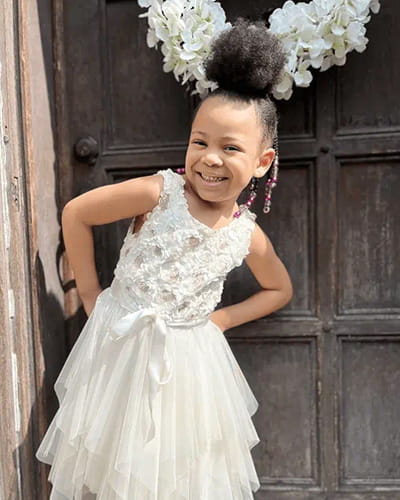Thirty years ago, Denae’s diagnosis with sickle cell disease meant a childhood of frequent hospital visits and painful crises.
Today, her 6-year-old daughter Mariam — diagnosed at birth with the same condition — runs, plays, and thrives without ever experiencing a crisis.
Just a generation apart, there’s a world of difference in the treatments this mom and daughter received.

years apart show just how far treatment for the disease has come.
When Denae was born, newborn screening for sickle cell disease wasn’t yet standard. She was diagnosed and began daily penicillin therapy when she was six months old following her first painful crisis.
From that moment on, Denae’s life became a cycle of hospital stays, pneumonia infections, and even a stroke at age seven. Chronic transfusion therapy became her lifeline, bringing her to Cincinnati Children’s every month.
There, Denae found comfort in the care she received and was inspired to become a nurse practitioner because of it.
“Despite being in the hospital, I still had a normal childhood,” she said. “I did everything I wanted to. I have sickle cell — that’s what I have. It’s not who I am.”
So, when Denae was told her newborn had sickle cell disease, she said the news was devastating, but not hopeless.
“Even though I feel I had a good life, you still don’t want your kid to go through any type of pain,” Denae said. “And those concerns just melted away. I felt so hopeful and encouraged that she’s going to be OK.”
Thanks to advances at Cincinnati Children’s Cancer and Blood Diseases Institute and Sickle Cell Center, Mariam’s experience has been remarkably different. She began hydroxyurea therapy at just six months old — a treatment that has helped her avoid the painful crises her mother endured.
Hydroxyurea has been a game changer for patients, eliminating most side effects and symptoms of the life-threatening disease.
“We are one of few hospitals where more than 90% of our patients have been on hydroxyurea since a young age,” said Punam Malik, MD, Sickle Cell Center director. “It’s actually hard for us to study new therapies because our patients are doing so well.”
Sickle cell research at Cincinnati Children’s has its roots when the center was founded in 1973, when leading physicians advocated for the use of penicillin prophylaxis which greatly improved the survival of patients, including Denae.
Cincinnati Children’s is currently pioneering gene therapy — a potential one-time cure that uses a patient’s own stem cells and genetically engineers them to produce fetal hemoglobin, eliminating the need for daily medication. While bone marrow transplant has been an option to cure sickle cell disease, it’s only available to a small number of children who have a matched donor.
Two genetic therapies received FDA approval, offering hope for a future free from sickle cell disease.
“Every patient is their own donor because we fix the patient’s own bone marrow stem cells,” Malik said. “That means every patient with sickle cell has this option.”
This research ultimately reaches the bedside benefitting patients like Mariam, empowering them to live pain-free.
“I hope the best thing that we’ve been able to give to Mariam is a normal childhood,” said Charles Quinn, medical director for the hospital’s Pediatric Sickle Cell Program. “She hasn’t had severe pain or complications from her sickle cell disease. She’s going to school. She’s growing and developing well. It’s the things that she’s avoided that are helping her stay healthy.”
Denae never expected to be back at the pediatric hospital seeking sickle cell treatment 30 years later.
“When I think about why we are at Cincinnati Children’s, it’s because I think it is the best place for her to be,” she said. “I know they’re just a call away. That level of care isn’t always common, but it’s common for us.”
And for Mariam, the benefit is simple: “They made me feel better. And I get to go home.”


